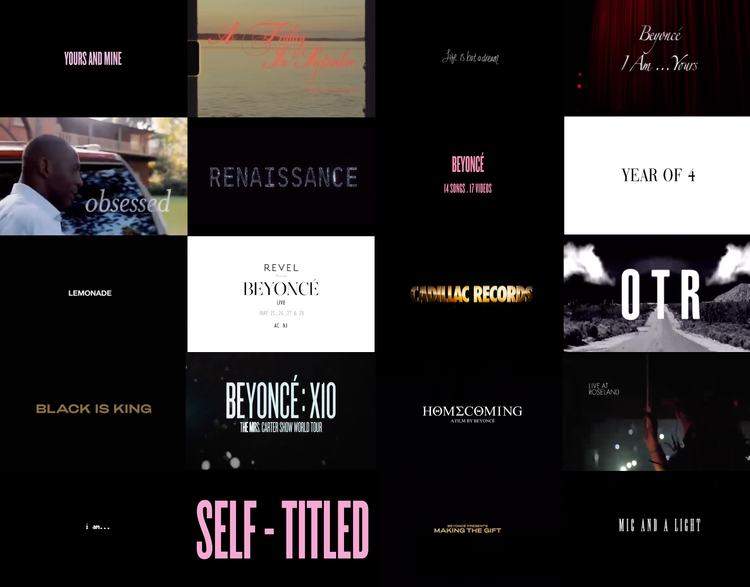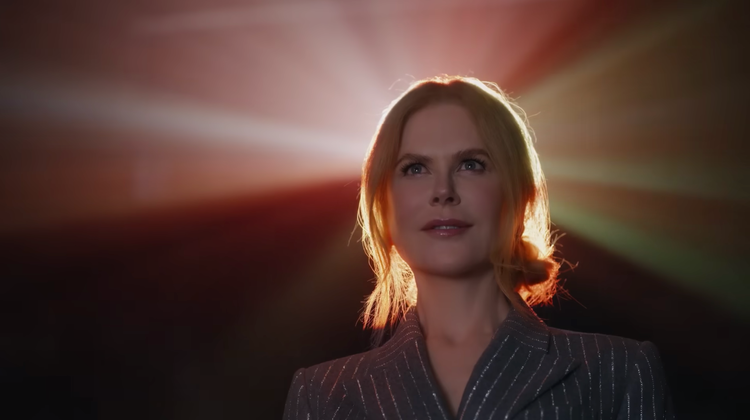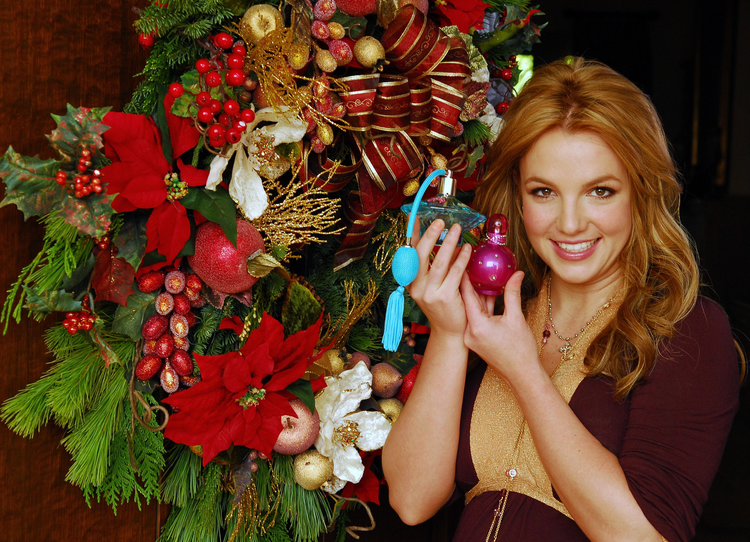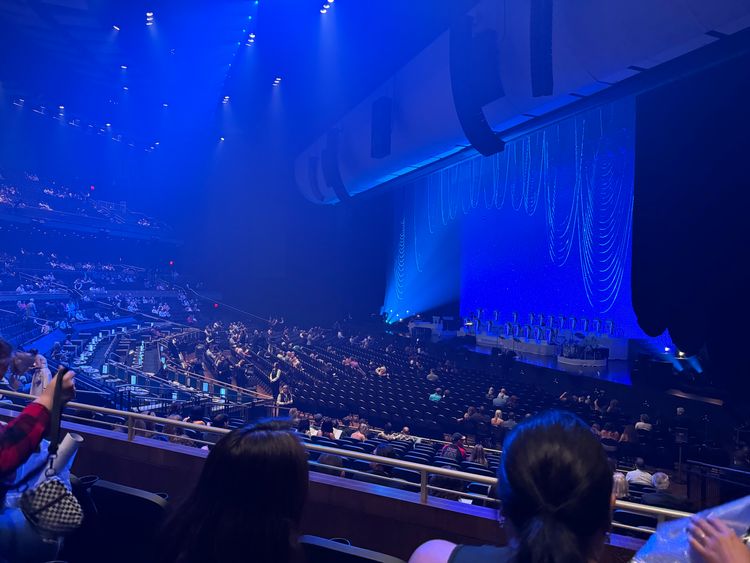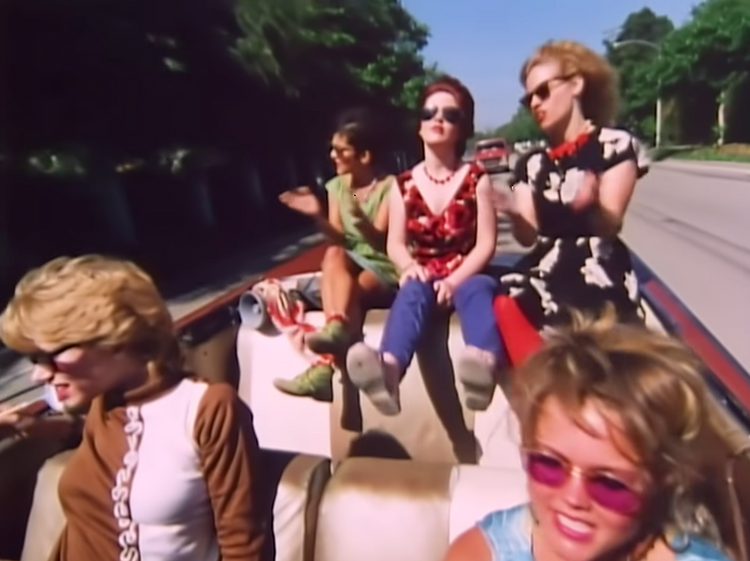MM File: B. Åkerlund

Today I’m kicking off what I picture as an indefinite series called “MM File”—as in mind map, but also Mononym Mythology. Every so often, I’ll dive into a visual artist who interests me and/or follows me around as I go about my work, but who isn’t necessarily a musician: directors, but also photographers, designers, stylists, dancers, video vixens, and whoever else comes up.
Some of these will be excuses to watch back a bunch of my favourite stuff and take notes on a different element than usual, sometimes they’ll be reasons to finally get caught up on someone, and sometimes I’ll be courting a future interviewee. And I’m happy to admit to the latter in today’s case, where I’m doing something I generally wish I did more of and am writing about clothes.
Something I’ve told people many, many times about director Jonas Åkerlund is that you know his work regardless of whether you know his name. That’s potentially even truer of his wife, Bea—known professionally as B.—who’s been the costume designer on much of his stuff but also plenty of projects totally unrelated to him. Before we begin, here she is in a nutshell, which is to say an IKEA spot directed by Jonas:
If you’ve paid even cursory attention to pop culture at any point during the past couple of decades, B. has been right there under your nose, one of the things that fascinates me most about her. The artist(s) of your life could be Madonna, or ABBA, or the Red Hot Chili Peppers, or even Ozzy Osbourne, and I could pull up an image right now of them wearing something that originated in B.’s mind; she’s someone who rightfully refers to herself as an “image-maker.”
The images in question also tend to last. If there’s a defining one of Beyoncé’s Lemonade (2016)—an element that persisted most across the header images and the memes, the illustrated children’s books and the Etsy creations—then it may be the artist herself wielding a baseball bat draped in that mustard Roberto Cavalli gown. The star herself seems to agree, which is probably why she recently wore it again in that Verizon Super Bowl commercial when she needed to reference Lemonade.
As the New York Times wrote of Åkerlund in 2013, “In an era when the red-carpet entrance has been commoditized to a high sheen, broken down into a laundry list of product credits, she sees herself more as a storyteller, helping pop stars to visually define characters that serve a narrative and enhance their artistic bona fides in the process.” When people decided to dress up as Lady Gaga for Halloween in the late 2000s/early 2010s, there’s a good chance they either a) glued a bunch of bubbles to a nude bodysuit (à la her 2009 Rolling Stone cover) and called it a day, or b) tried to recreate her Minnie Mouse-print ensemble from “Paparazzi” (2009). And yes, B. was behind both of those looks.
“I know that when I’ve created an outfit that someone makes a Barbie doll out of, or [does] an illustration, I’ve succeeded because I’ve inspired somebody out there with what I do,” the stylist has said of her work. “And I feel like if that doesn’t happen, then I haven’t done a good job.”
The Åkerlunds first met when B. was hired as the costume designer for Jonas’s debut feature, Spun (2002), the MTV-inflected, significantly more fun cousin to Requiem for a Dream (2000). As Jonas has told the story, a different designer had originally been hired but then dropped out, and Mickey Rourke—one of the film’s stars, without whom we wouldn’t have this scene—suggested B. as a replacement. (She’d been the costume designer on another film of Rourke’s from a couple years back, Out in Fifty [1999], and had apparently done some other work as his personal stylist.) “First I thought, She’ll only do Mickey, and I’ll get someone else to do the rest of the cast,” Jonas has admitted. “But she ended up doing the whole movie.” The two have been married since 2008, the same year they became parents to identical twin girls, and now split their time between Los Angeles and Stockholm.
(As a funny side note that I might not ever have a reason to share elsewhere: for a long time, I assumed that twins and doubles were often appearing in Jonas’s work—in “Hold It Against Me” [2011], where Britney Spears battles an alternate version of herself; or in Beyoncé’s “Haunted” [2013], where there are two B. lookalikes in pinstripe suits among the characters; or in the underwater portion of Lemonade, where Beyoncé A watches Beyoncé B sleeping—because the director had twins. But then I realized that twins had actually started to appear in his stuff long before then, at least as far back as Roxette’s “June Afternoon” [1996]. When I asked him about this during our first conversation in 2020, he told me that it was just one of those weird coincidences: “Twins are always funny and weird and scary. [B. and I] always wanted twins, so it was really weird when we got them … It’s like pure luck, it’s magical.”
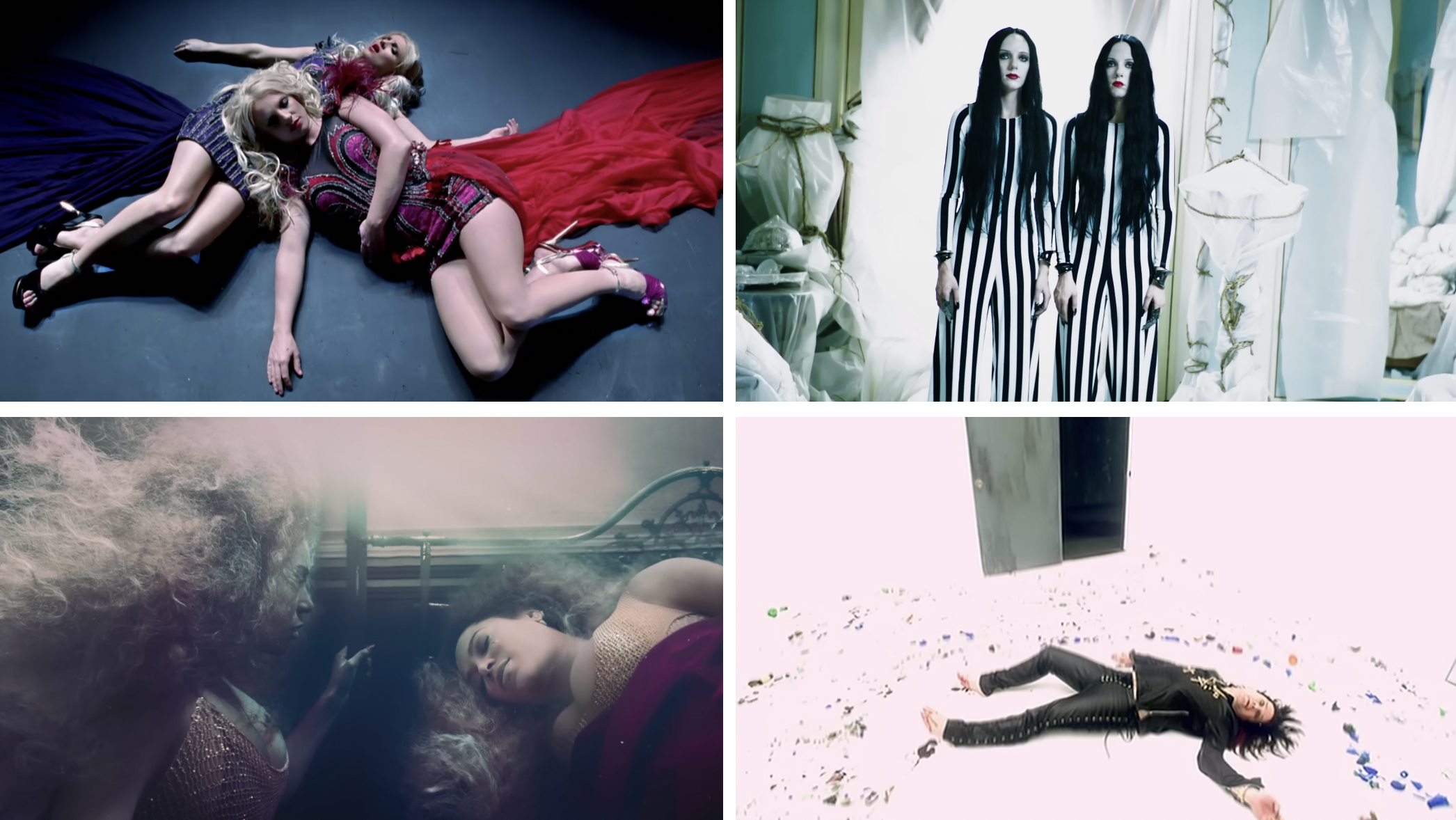
The first music video the couple ever did together seems to have been Ozzy Osbourne’s “Gets Me Through” [2001], where Ozzy has a double that he’s gazing at in different rooms in a hallway, “Justify My Love” [1990]-style—not unlike in “Haunted.” So the Åkerlunds may have actually manifested their twins a couple different ways. Now I’m also realizing that Beyoncé could be argued as having done the same, but that’s for some other time.)
Jonas has said that he’d never before worked with a costume designer so interested in getting the little details right for a character; B. is known for going above and beyond in terms of research, often showing up for jobs with a sizeable book of reference images. “I always like to study and understand the realness of where my subject is coming from,” she’s said, “the customs, the country, and so on.” When she was spearheading Madonna’s Roman Empire-themed Super Bowl halftime show in 2012, a job that required her to dress hundreds of people (and that she considers her magnum opus), she “did extensive research on the history of the empire, including flying to Rome itself.”
Here’s another sample quote, on designing tour costumes for Ghost: “[The band has] this religious undertone, but I’d never really known the names for the traditional garments worn by a priest, so I started to really get to the bottom of each piece to learn what it meant. Then I put my own spin on that. I got half of the costumes made in specialist religious stores, then I hired fashion designers to create something new.”
At the same time, Jonas is a director particularly interested in capturing tiny details, famously grabbing what might seem to onlookers like a ridiculous amount of coverage so that he has lots of freedom in the editing room. “If there’s a really amazing detail, he will get it,” B. has said, noting that it means she never does her weeks and weeks of prep for naught. There were times writing my MA thesis back in 2020 when I’d want to talk about a certain barely-noticeable aspect of the costume design—perhaps a Confederate flag sewn onto Johnny Knoxville’s denim vest in Jonas’s Small Apartments (2012), something that helps hammer home his character being a deadbeat loser—but not necessarily know which half of the couple had been behind it. Not that it necessarily matters: the authorship there being blurry is a perfect illustration of how well the couple’s sensibilities go together.
But I did want to better put my finger on what exactly B.’s sensibilities are, since I don’t love the idea of them being conflated with/subsumed by her husband’s. So you can consider the rest of this dispatch a sort of narrativized taxonomy of B. Åkerlund’s creative stamp, featuring lots and lots of pictures. Pretend that I’m standing in front of you delivering a PowerPoint (in some freshly applied Ruby Woo).
B. was born in Stockholm in 1975, but relocated to Los Angeles with her mom—a beautician by trade—at 14. Shy but always clothes-obsessed (they “were a way for me to not have to speak,” she’s said), she started collecting vintage stuff and regularly turned up for class dressed in some sort of self-conceptualized theme, maybe wearing a single colour from head to toe or emulating a Boy Scout—“whatever I could do to express myself.” When she dropped out of high school during an “unruly” period, she was kicked out of the house, and a photographer neighbour encouraged her to get into styling, saying that it would essentially be doing what she did to herself all the time but for other people. “I would go to the clubs and dress up in wigs, full-on drag,” she’s said. “At the time, nobody knew what a stylist did. He explained it to me and he gave me my first job. I did a calendar with drag queens and I dressed them all from my closet. I was like, That’s easy, and it escalated from there.”
The stylist has said that she felt like she’d finally made it when she did the Beastie Boys’ 1998 Rolling Stone cover, but that was really just the beginning of high-profile music work. The next year, she styled Methods of Mayhem’s “Get Naked” (1999) video, putting Lil’ Kim in a yellow cowboy hat and pasties—the earliest look of B.’s I’ve seen that I’d file under wacky Americana. She’s been responsible for lots of memorable cowboy moments since; you’re already familiar with the disco-ball cowboy hat that popped off after Beyoncé wore it on her Renaissance World Tour poster, but B. was how it ended up on the star’s head in the first place. (She’s almost always uncredited or referred to as an unnamed “stylist” in news stories about it.) You should assume that none of these slide categories are mutually exclusive, but let’s see WACKY AMERICANA:
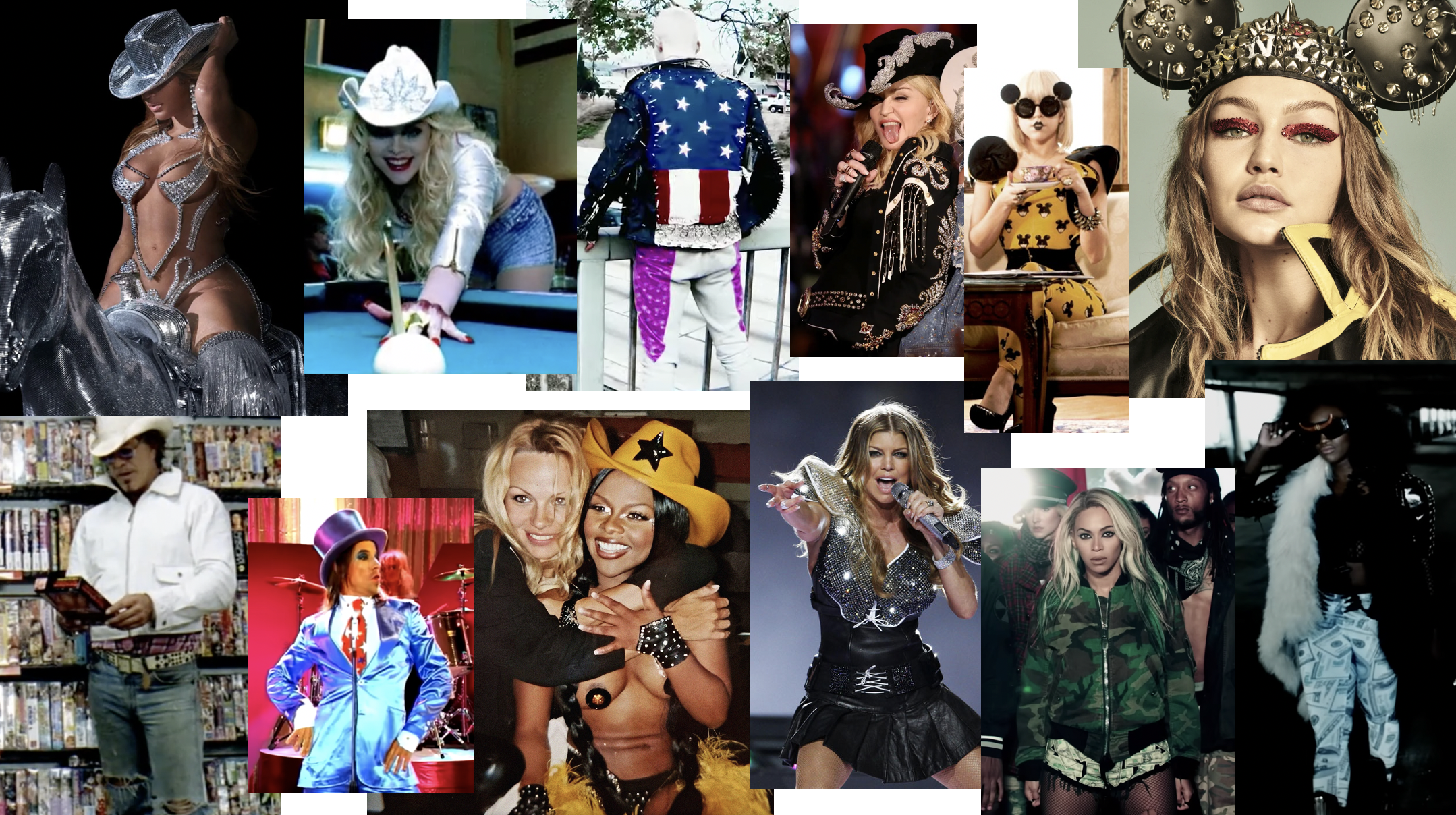
Only around half of the above screenshots had anything to do with Jonas, but the Åkerlunds have generally been hired for many a commentary on American culture—an idea that’s especially interesting to me because they bring a sort of outsider perspective to the country. I wrote my thesis about American suveillance culture in Jonas’s work (think Gaga calling the paps on herself in “Paparazzi,” or Beyoncé taking that CCTV camera out in “Hold Up” [2016]), and that involved noting down whenever a project contained an actual American flag. I happened to find a lot of them in the costume design; there are at least two Jonas-directed projects I can think of—Beyoncé’s “Superpower” (2013) and a short he made called Beyond the Skin (2014)—for which B. fashioned someone in a cool leather jacket featuring the Stars and Stripes.
Speaking of jackets: “Get Naked” also features Lil’ Kim wearing one of many enviable pieces of outerwear in B.’s oeuvre, so here’s a COOL OUTERWEAR slide:
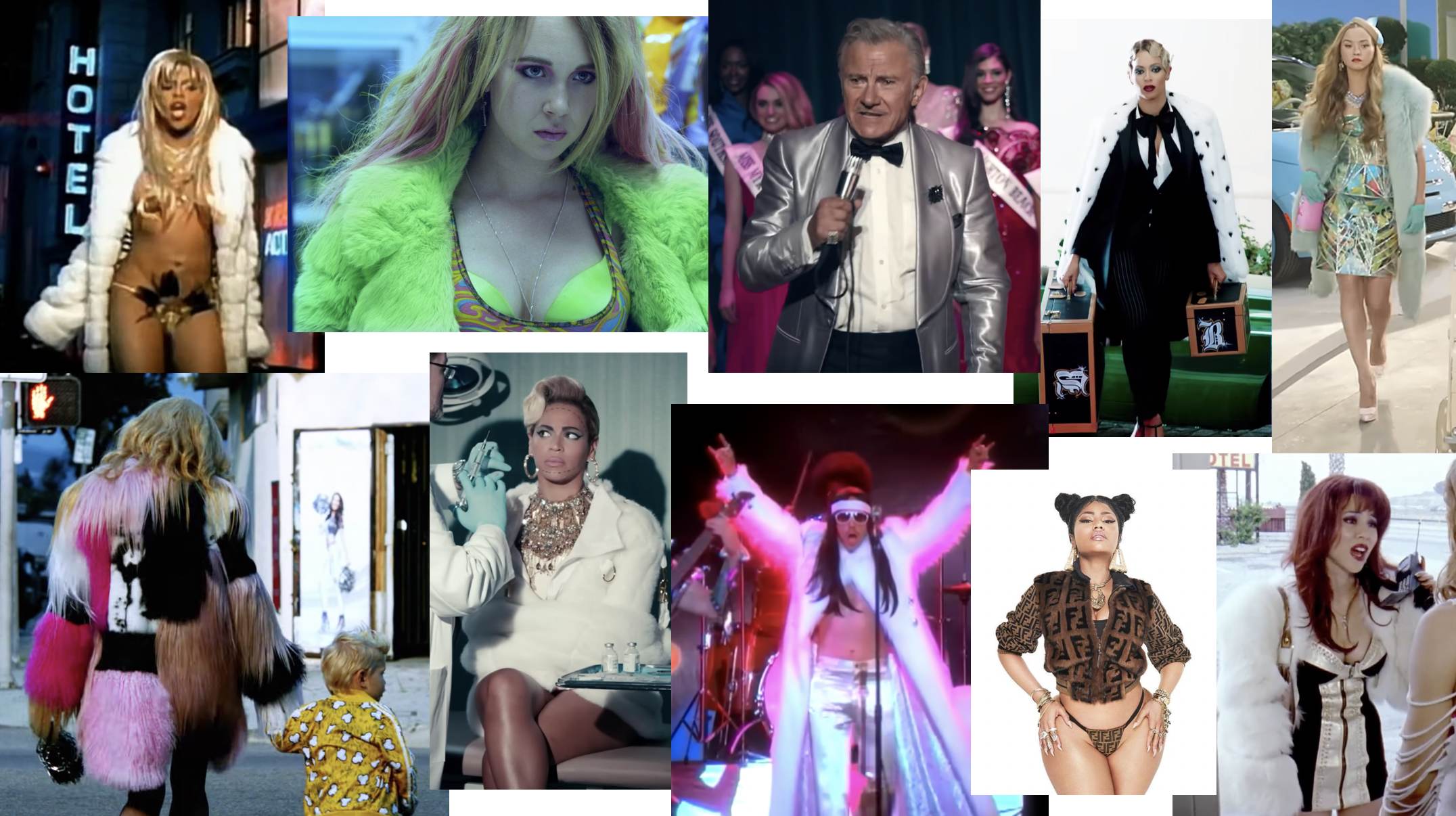
While Jonas had first started working with Madonna back in the ‘90s with “Ray of Light” (1998), B. didn’t get to work with her until the Jamie King-directed “Sorry” (2006) almost a decade later. After that, she’d appear all over the superstar’s visuals, and very often working sans Jonas—doing costumes on Filth & Wisdom (2008), helping to shape the overall look and feel of both Hard Candy (2008) and Rebel Heart (2015), and dressing Madonna for plenty of one-off performances and projects (her Prince tribute in 2016, her big Vanity Fair spread last year, etc.). B. was bombarded with hate in 2015 after Her Madgesty was yanked offstage by a cape that was supposed to detach around her neck—a mistake for which B. has said she wanted to die—but she’d apparently flagged that the bow was a risky proposition beforehand. I’m officially declaring her innocent in this story, no matter what Swedish Wikipedia says:
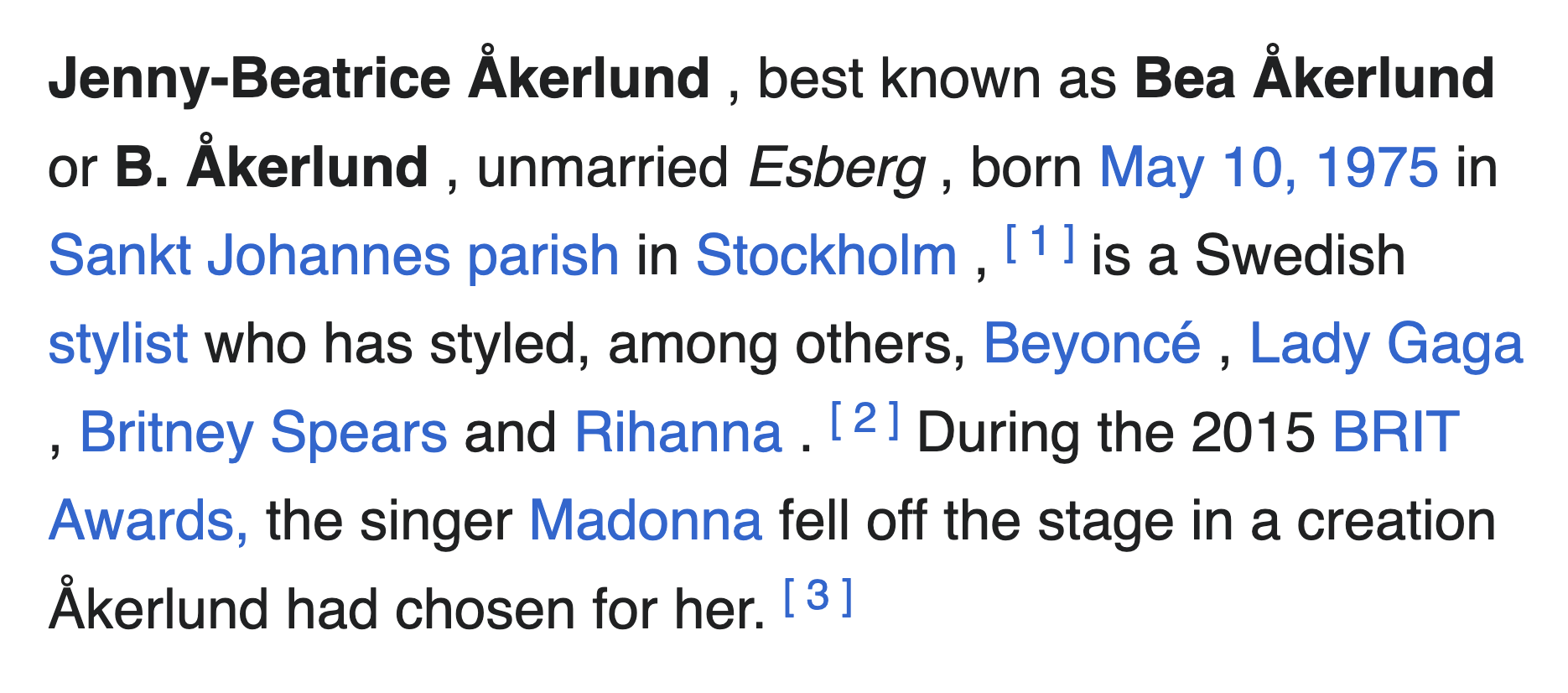
B.’s looks often combine high and low things (think a rare archival piece paired with jewelry you bought at a gas station) and/or hard and soft things (think spandex layered over with a metal brace of some kind), and always with an emphasis on creating cool shapes. A named influence that’s interesting to consider through that lens is the late costume designer Eiko Ishioka, who came up with some wild structural shit for Bram Stoker’s Dracula (1992) and The Cell (2000). There’s often some kind of literal hardware involved in the shapes of B.’s work, which necessitated an INTERESTING HARDWARE slide:
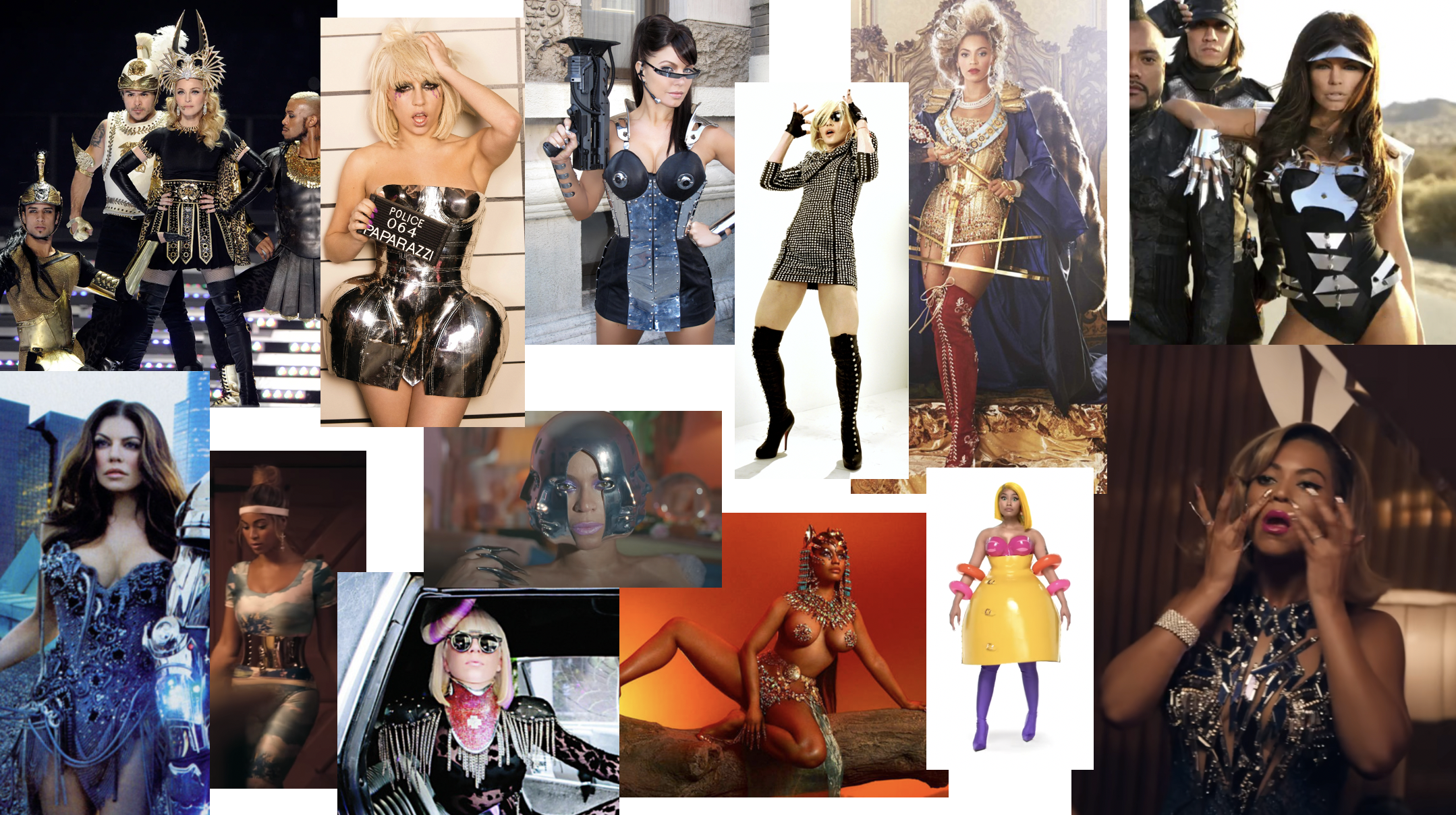
But again, she’s very likely to pair that hardware with something soft, like lace or lingerie or even latex (more on that last part in a bit). She’s whipped out vintage lingerie for cilents many times—Beyoncé’s “Partition” (2013) plays a bit like a highlight reel on that front—but she’s also presented lingerie in lots of unexpected ways, like how the cups of Madonna’s bra in “Turn Up the Radio” (2012) are totally visible. I gave MEMORABLE LINGERIE its own slide, though there’s obviously memorable lingerie all over my others:
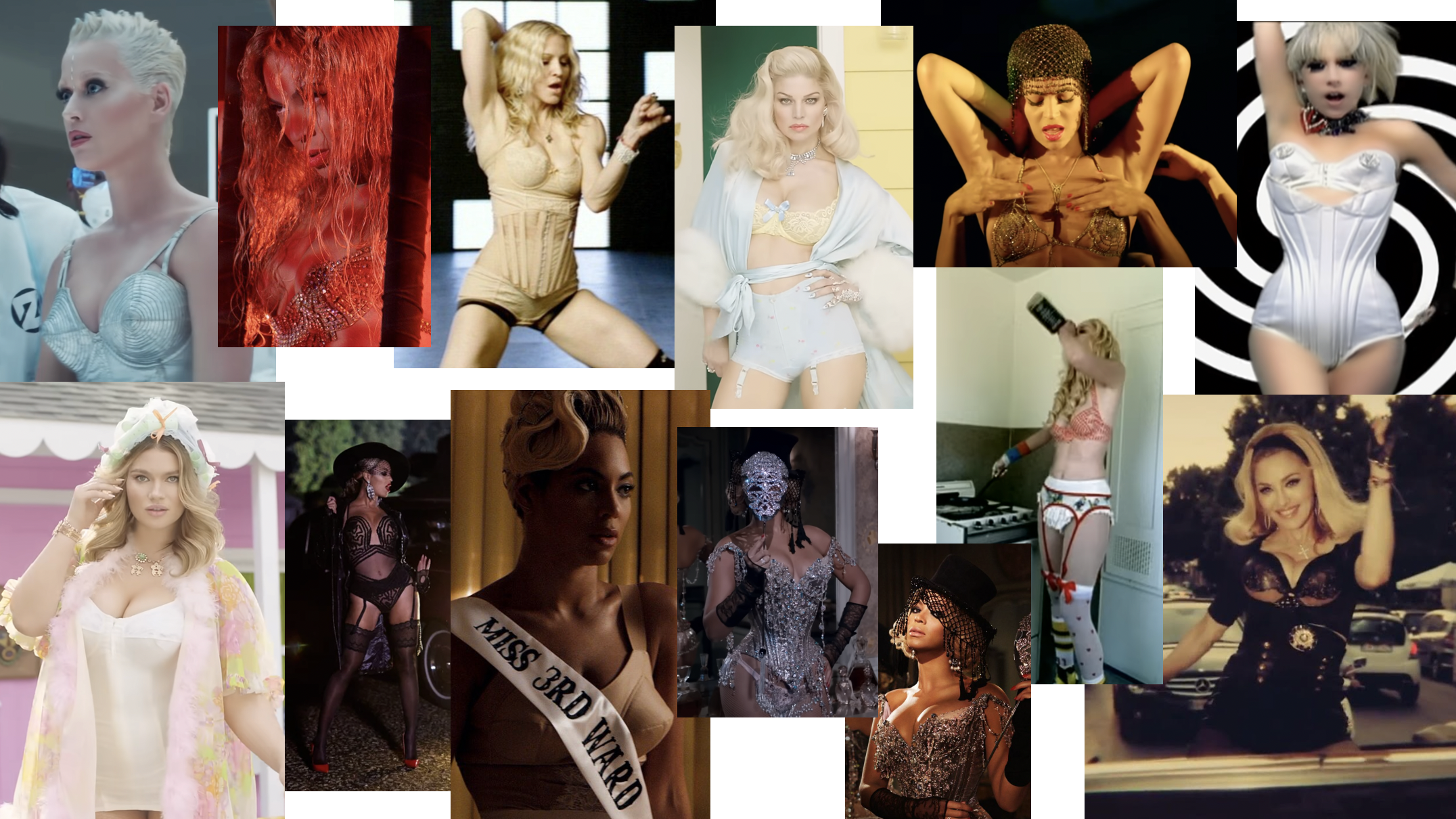
B. found out that she was pregnant with twins right before a promo tour she would have been styling for Madonna and pulled out, wanting to take the time totally off of work. During her mat leave, a relative unknown by the name of Lady Gaga started expressing an interest in working with her; for multiple videos, they did a dance where Gaga would call B. and ask about her availability, and B. would politely decline in the name of her pregnancy. But this was mostly on principle, since she was apparently dying of creative overwhelm behind the scenes, doing things like bedazzling baby furniture. The two women did have some sort of sit-down meeting where B. has said it was early enough in Gaga’s rise that the Chateau Marmont had never heard of her.
Eventually, the young star reached out to Jonas instead, needing a director for “Paparazzi.” And by that point, B. felt ready to burst with ideas: “I basically exploded on her … I felt like I threw up on her,” she’s said of the job. The “Paparazzi” video is almost like you distilled both Åkerlunds down to an essence, and that includes how it opens with a Swedish dialogue scene between Gaga and a then-emerging actor friend of the couple’s, Alexander Skarsgård. (The way Skarsgård tells this story suggests that Jonas used a costume-design detail—his character’s eye patch in the video—to help sell him on being in it.)
“When I did prep that video no one really knew who she was,” B. has said of Gaga and “Paparazzi.” “So I had to convince designers to lend me clothes. It was funny because after that video, the whole world knew … I remember the Dolce & Gabbana corset at the end [the second photo on INTERESTING HARDWARE], they were like, ‘No, we’re not sure.’ And I was like, ‘Oh, come on. Just do me this one favor. I really need that corset.’ And years later, that corset was showcased at the Louvre in Paris because she wore it.” There are also a half-dozen Mugler archive pulls in the video, since Thierry himself was friends with B.
For a stint thereafter, B. became Gaga’s first official stylist, and they’ve collaborated a number of times since. “Gaga reminds me of me, she’s like the little sister I never had,” B. has said. “It’s scary [how] alike we are.” If you listen to just about any interview with the stylist, you’ll hear that her speaking voice actually resembles that of a The Fame (2008)-era Gaga. But here’s something twice as spooky that B. once posted of herself:
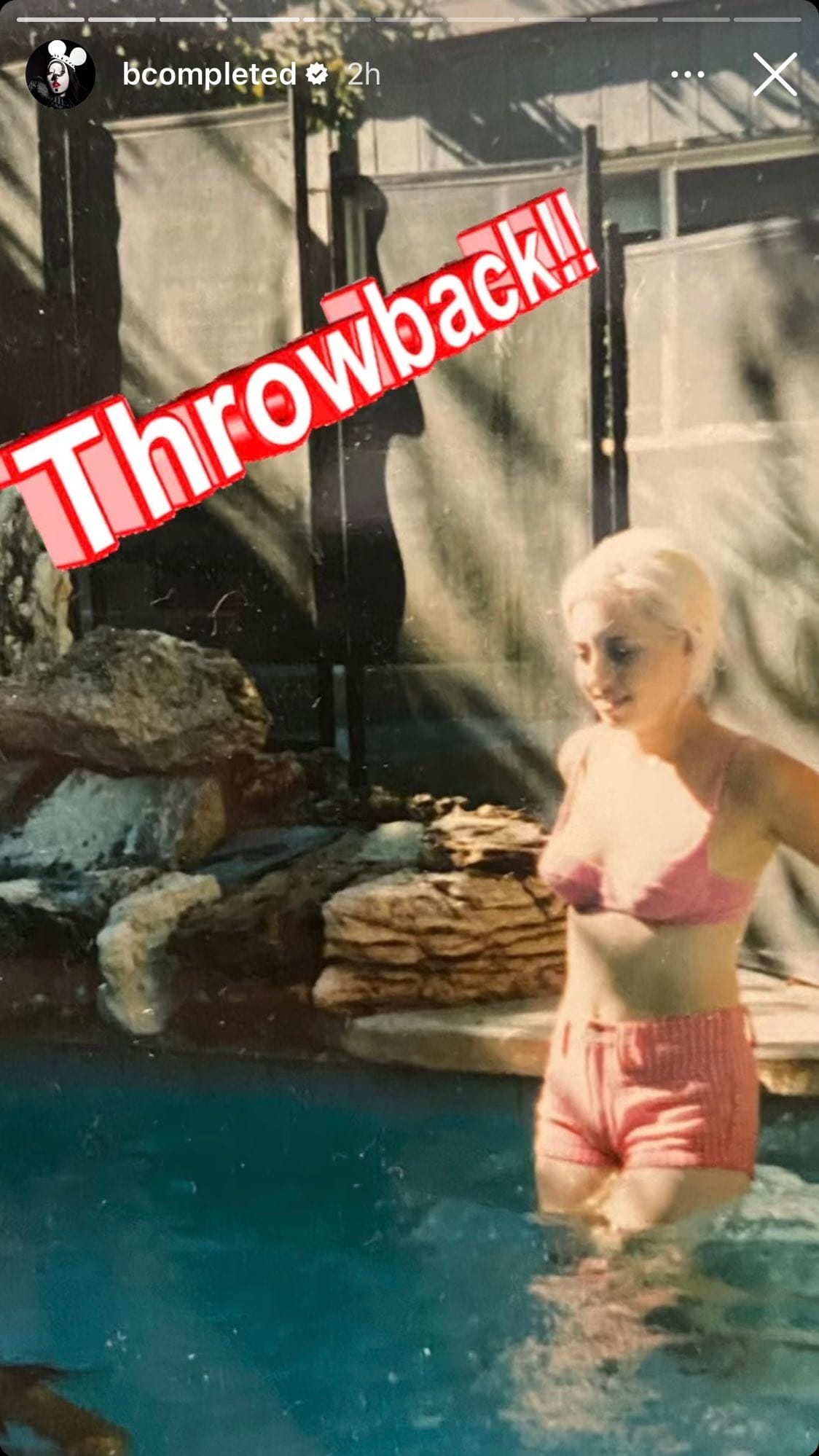
However much couture may have made it into “Paparazzi,” B. has suggested that such access is more a perk of the job than a necessity: “I don’t like to pull fashion; I like to make fashion. I feel like Gaga and I are alike in that respect. It doesn’t necessarily have to be about the new hot designers; it’s whatever we feel like doing at the moment.”
In 2013, B. and Jonas became go-to collaborators for another superstar, spending a lot of the year working as a pair for Beyoncé (who’d never worked with B., but had worked with Jonas on “Telephone” [2010]). Beyoncé is another artist well-versed in ‘making fashion’; major designers didn’t jump to dress Destiny’s Child early on, meaning that Tina Knowles was left to come up with as many of her own sartorial creations as she could. There are plenty of stories about Ms. Tina’s resourcefulness on the road to her daughter’s superstardom—like when she had to cut a dress “free-hand” out of fabric she’d bought that day in South Africa because Beyoncé was unexpectedly performing for Nelson Mandela.
In a similar spirit, there are anecdotes and photos of B. all over the internet simply scrounging a look together out of available materials, or distressing or burning fabric (sometimes with an actual blowtorch) until it looks just so, or making a costuming blip seem totally planned. In Primal Scream’s “Country Girl” (2006), the titular country girl’s platforms are visibly held together by duct tape—a detail in line with the character’s hot-mess self, but which sprang from the shoes truly being broken. In “Paparazzi,” there’s a look Gaga wears that’s made out of film stock, which B. and designer Jeremy Scott apparently spent several minutes wrapping around her until it felt like an outfit.
But back to pulling fashion for a second: for the Jonas-directed Mrs. Carter Show World Tour promo at the top of 2013, a look that B. sometimes names as her favourite she’s ever styled, she again borrowed from the Mugler archives to help create a modern Elizabethan get-up for Beyoncé. (As an interesting point of comparison, Margot Robbie had the same corset on at an Oscars afterparty earlier this year, and her look felt altogether less… styled.) I love that the promo itself actually revolves around Beyoncé getting into the look B. created for her. (Both Åkerlunds make quick onscreen appearances when Sean Bean—just go with it—starts speaking towards the end.)
While Jonas directed two videos from Beyoncé’s self-titled album later in the year, “Haunted” and “Superpower,” B. worked on an additional two without him: Melina Matsoukas’s “Pretty Hurts” and Jake Nava’s “Partition.” On almost all of those, B. also had to dress a host of supporting characters, including Harvey Keitel, the Destiny’s Child girls, Pharrell, Shaun Ross—the list goes on. She once told Billboard, “I travel with a truck. But, the rule is that you have two favorite racks and then everything else is backup.”
And in case you’re assuming that she doesn’t literally mean a truck, here’s how much stuff she brought to “Haunted”:
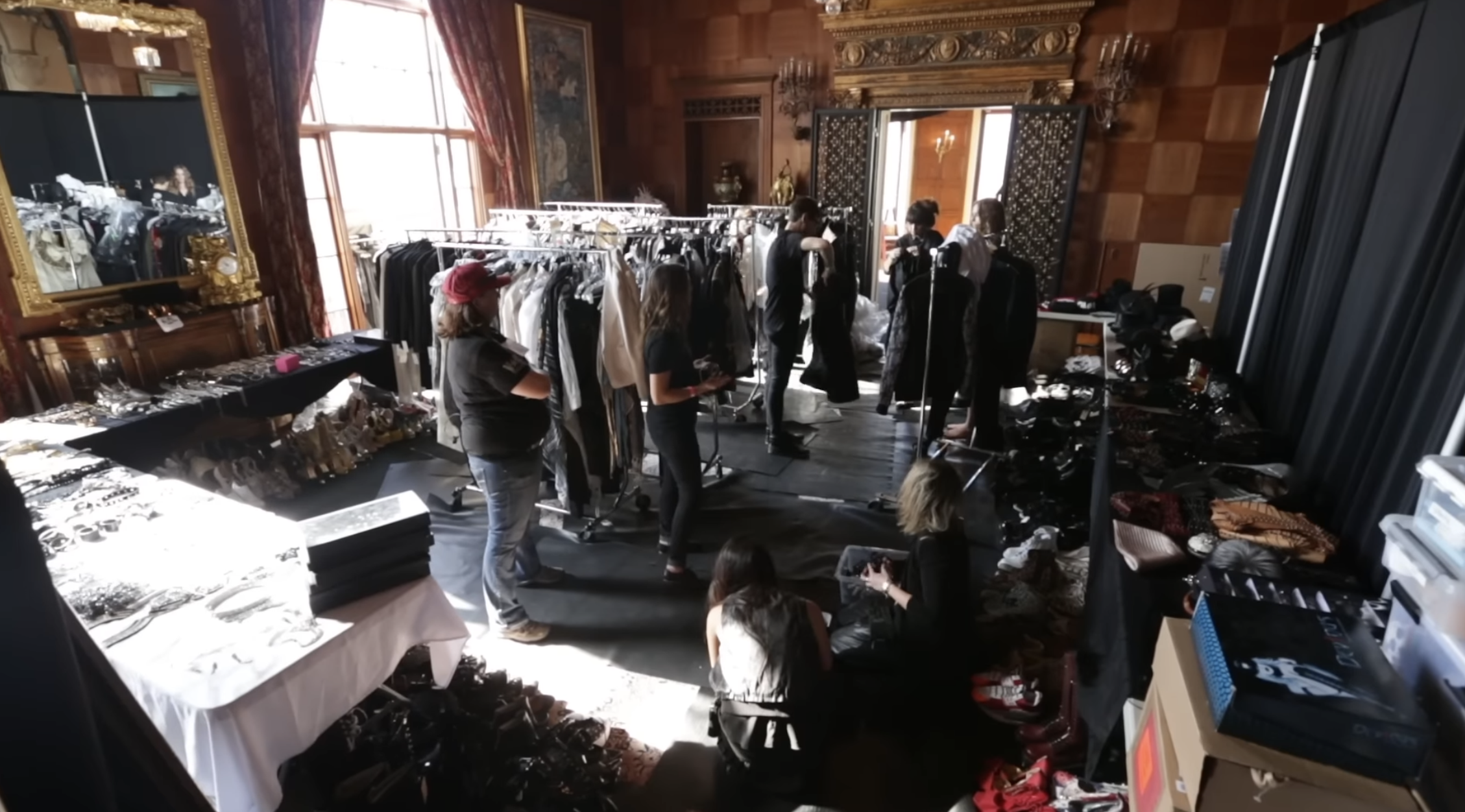
When I think of B.’s contribution to that album, what comes to mind is the idea that she’s often given major pop stars their their big goth(ic) moment(s), something that I think probably draws people to the Åkerlunds in general. It’s a chance to play around in the couple’s universe for a bit, to maybe indulge in some darker fantasy while wearing the couture to match. I rounded up some fave GOTH(IC) MOMENTS here:
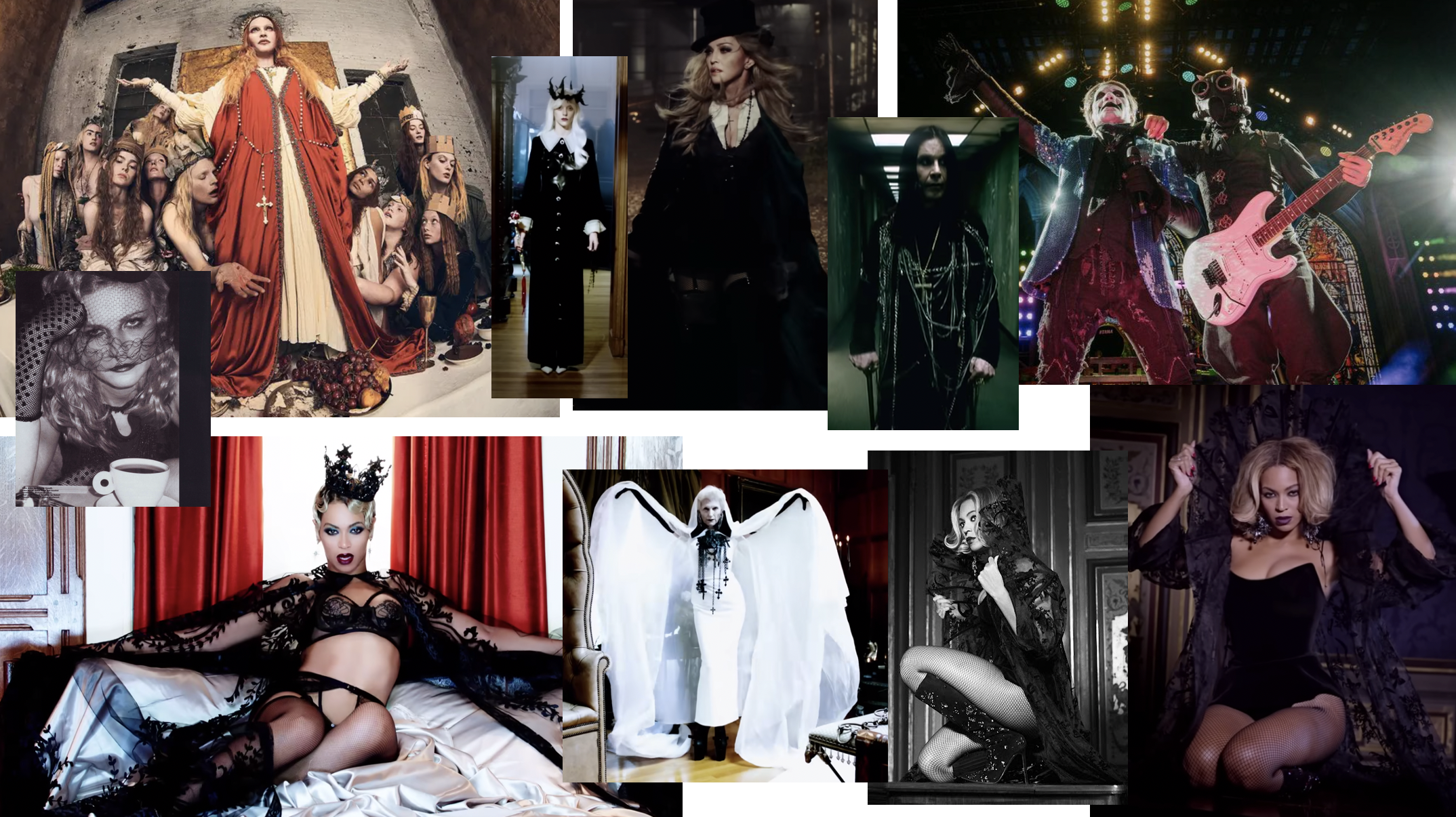
One of the cool things about B.’s relationship with Madonna, then, is how aesthetically in tune the two already were prior to meeting. Think of the Madonna Wannabes of the mid-‘80s, who decked themselves out in lace, crucifixes, and stacked jewelry in order to look like their idol—who, it should be noted, also started out having to ‘make fashion’ out of financial necessity. There are several moments on Madonna’s journey—the show-stealing bra straps of “Like a Prayer” (1989), the bejeweled D&G corset she wore during Truth or Dare (1991) promo, her very Victorian Olivier Theyskens look from the 1998 VH1 Fashion Awards—that come off like stepping stones on the way to B.
There’s also an argument to be made that everyone B. styles essentially cosplays as her for that moment in time. “I never put anything on anybody I wouldn’t wear myself,” the stylist has said, and her Instagram feed totally corroborates this. As one profile put it, “A flesh-and-blood reverberation of the mesmerizing, maximalist fashion fantasies she creates for album art, music videos and performances, Åkerlund is frequently her own best advert—a ‘project’ she has been cultivating since moving from Sweden to Los Angeles.”
Working as a pair, the Åkerlunds’ most recent collaboration with Beyoncé, at least as far as we know, is “Hold Up”—and you might not realize if you’ve never seen the runway version of that Cavalli dress that she doesn’t appear to be wearing the sleeves properly; it seems like they’re dangling at her shoulders. It also wouldn’t be quite the same look without the star’s Agent Provocateur bra—it’s a Lindie, so says my research—poking through.
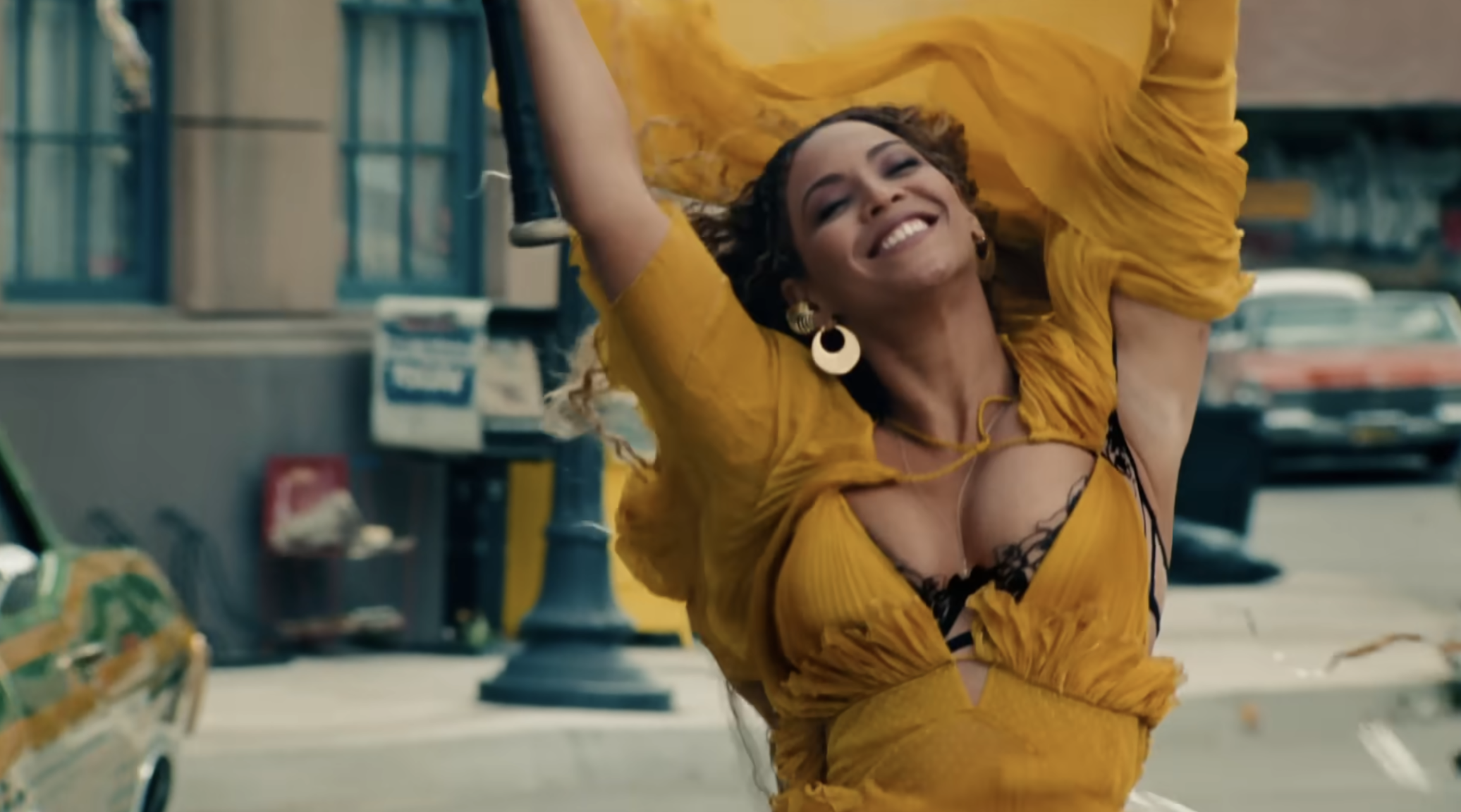
According to B., Jonas apparently “just insisted on a yellow dress—that was his vision from day one. He kept saying, ‘yellow dress, yellow dress, yellow dress.’ So I basically got every yellow dress from here to the moon.” The team had already landed on a different one for “Hold Up” when the Cavalli number showed up right off the runway, convincing everyone to switch gears partly through the shoot. The couple had managed a similar synergy on “Haunted,” where Beyoncé ended up dressed more or less as Jonas first pictured her when he was pitching her on the concept.
I don’t have any reason to believe that Jonas is involved with the mystery project Beyoncé has been piecing together these past few years, but we know that B. played some kind of role in it, having laid claim to multiple frames from the “I’m That Girl” teaser that was posted back in 2022.
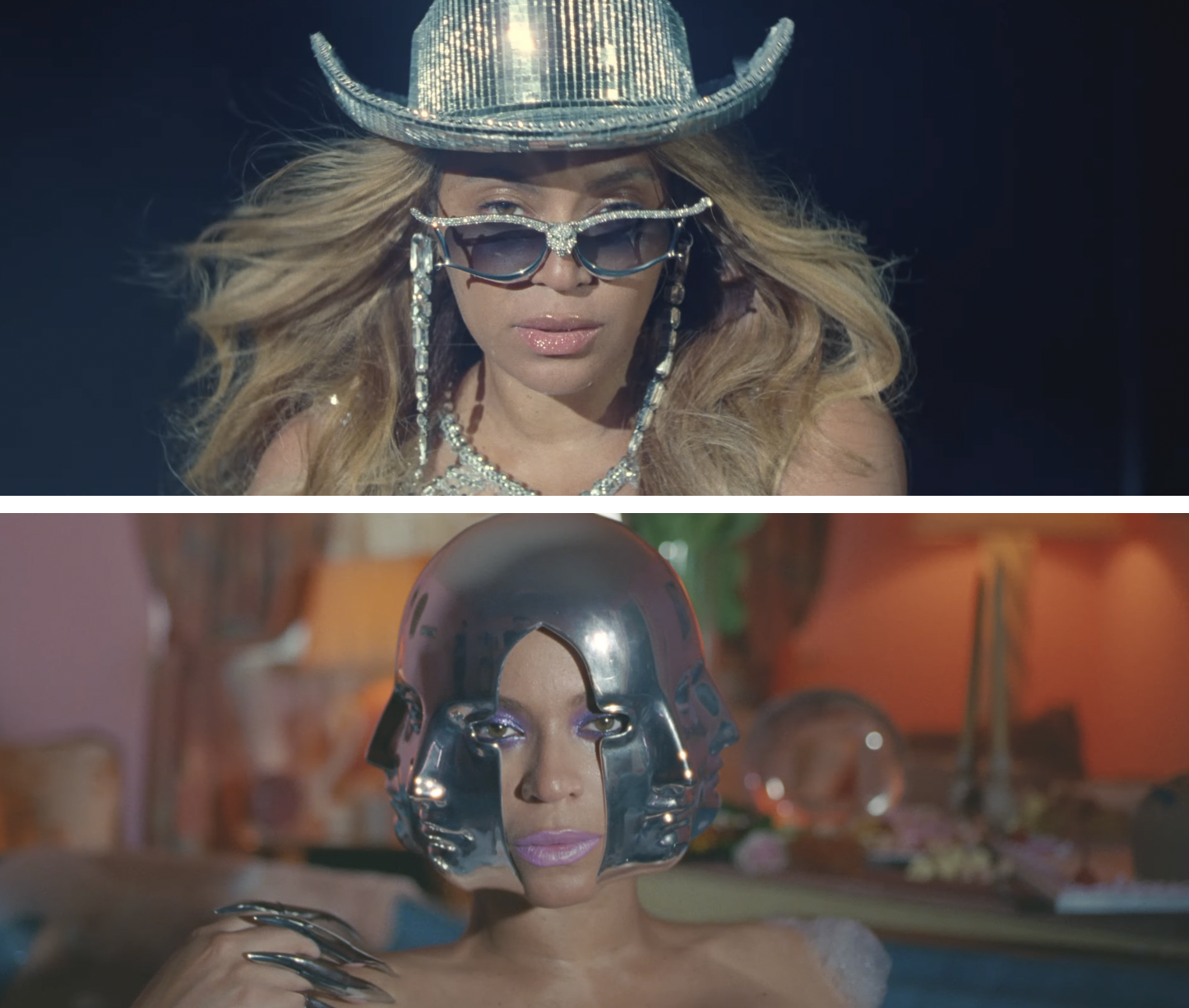
I mentioned a second ago that you’re very likely to see B. wearing something she’s dressed a client in, and a great example is how she wore a Heidi Lee “Endless Echo” hat (as seen on Beyoncé above) just days after the teaser dropped, to Madonna’s 64th birthday party.
Like her husband, B.’s resume is an eclectic mix of print, commercials, music videos, and films, though she additionally boasts numerous live performances and red carpet appearances. She’s said that movies are her “retirement plan,” citing Oscar-winning costume designer Colleen Atwood as an inspiration; one non-Jonas film I haven’t mentioned yet is Tony Scott’s Domino (2005), where B.’s involvement comes through in the studded motorcycle jackets and colourful animal print favoured by Keira Knightley’s titular bounty hunter.
There’s at least one music video B. has directed so far, a version of Laleh’s “Colors” (2015), and sometimes she’s credited as an overall creative director—as was the case on Fergie’s “M.I.L.F. $” (2016), directed by Colin Tilley. (There’s a clip from Keeping Up with the Kardashians that circulates every so often on social media where you can see Kimye override B.’s authority as creative director—and I, like the many people who reliably show up in the comments, think Kim looked swaggier before they did so. B. had worked with Kanye previously on his cancelled Fame Kills Tour with Lady Gaga.)
“There was something that attracted me to mixing latex and diamonds, as well as the use of color, to help create a world where women ruled and there was no limit to what you can do,” B. has said of the scene she helped set for “M.I.L.F. $.” At some point, a LATEX AND LEATHER slide began to emerge pretty naturally, a solid half of it coming just from that video.
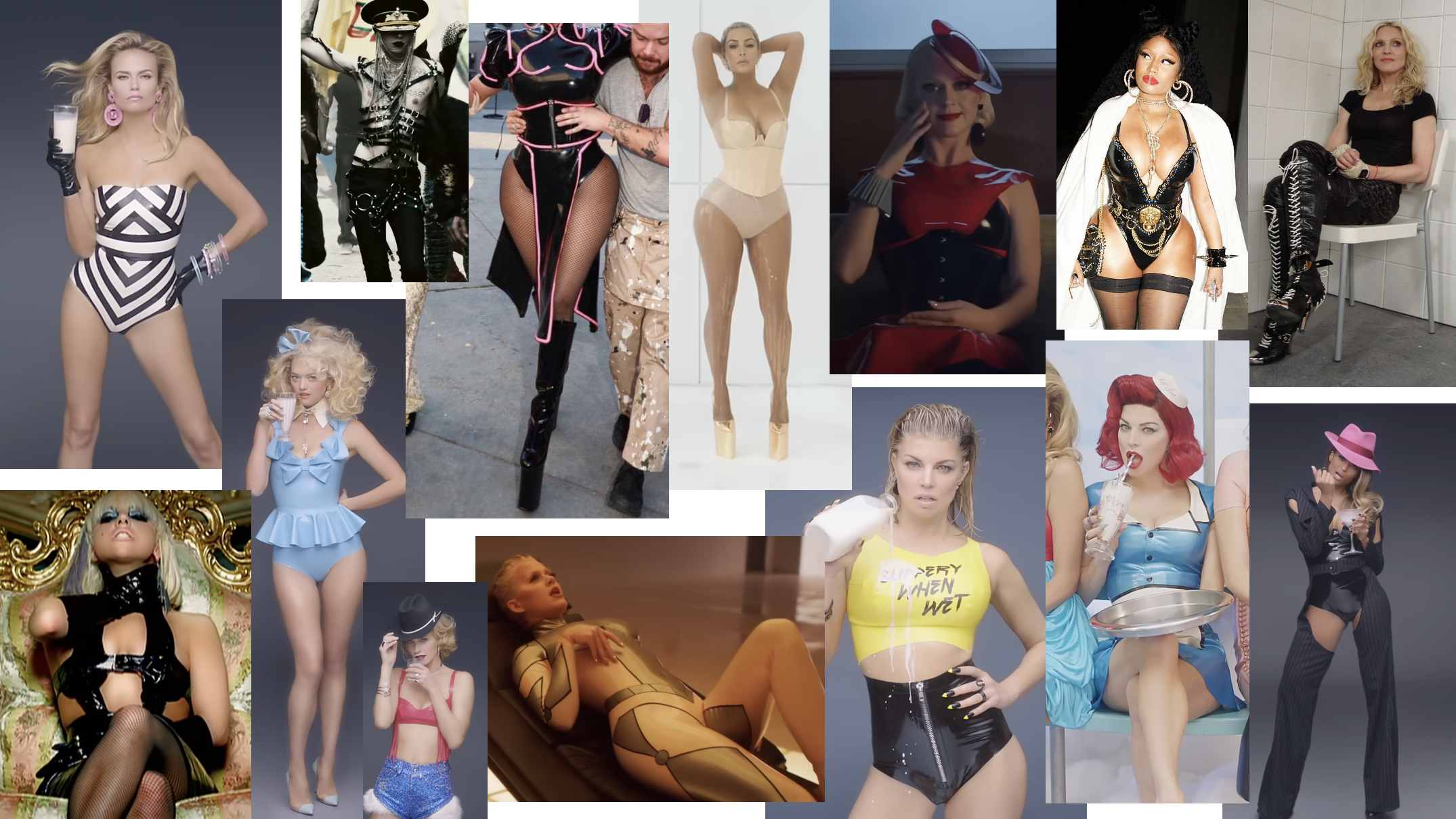
Between this slide and WACKY AMERICANA, perhaps you can see why I first assumed that B. had styled the album cover for Beyoncé’s Cowboy Carter (2024), but that was in fact the work of fellow Lemonade stylist Shiona Turini.
A slide I didn’t have quite enough material for, sadly, was light-up clothes; in the third photo above, of Nicki Minaj on the set of Steven Klein’s “Chun-Li” (2018), the pink lines are actually custom LED strips—you’ll have to watch the video to see how they looked in action. Those were also LEDs on Fergie’s outfit during the Black Eyed Peas’ halftime show in 2011 (pictured on WACKY AMERICANA), and Fergie later got to wear multiple light-up looks in the Jonas-directed “A Little Work” (2017), from her Double Dutchess visual album.
These days, B. co-owns and co-curates the Residency Experience, a showroom in Los Angeles where she aims to support emerging designers—part of her role as a self-billed “fashion activist,” the title she tends to use over stylist or costume designer. (The other part is more creative-philosophical: “Everything is just getting safer and more controlled, and no one is thinking outside the box, expressing themselves [in line with] how fashion began and what it all stands for.”) She’s also the head costume designer for ABBA’s ongoing Voyage virtual residency, where the concept was apparently, “If ABBA never aged and if they were to go on tour now, what would they look like?”
Otherwise, B. has designed furniture, non-traditional engagement rings, dog accessories that sometimes find their way onto famous humans, and even a line of cool-ass gloves; she was behind the ones Tinashe wears in her “Uh Huh” (2023) video from last fall (styled by Yasi), with B. effectively becoming the creative focal point of a video she didn’t officially have anything to do with. ●
Mononym Mythology is a music video culture newsletter by me, Sydney Urbanek, where I write about mostly pop stars and their visual antics.
I do that for free—and actually pay to use this platform—so if you happened to get something out of this instalment, you’re more than welcome to buy me a coffee. The best way to support my work otherwise is by sharing it.
Here’s where you can say hello (if you received this in your inbox, you can also reply directly to it), here’s where you can subscribe, and I’m also on Twitter and Instagram.
